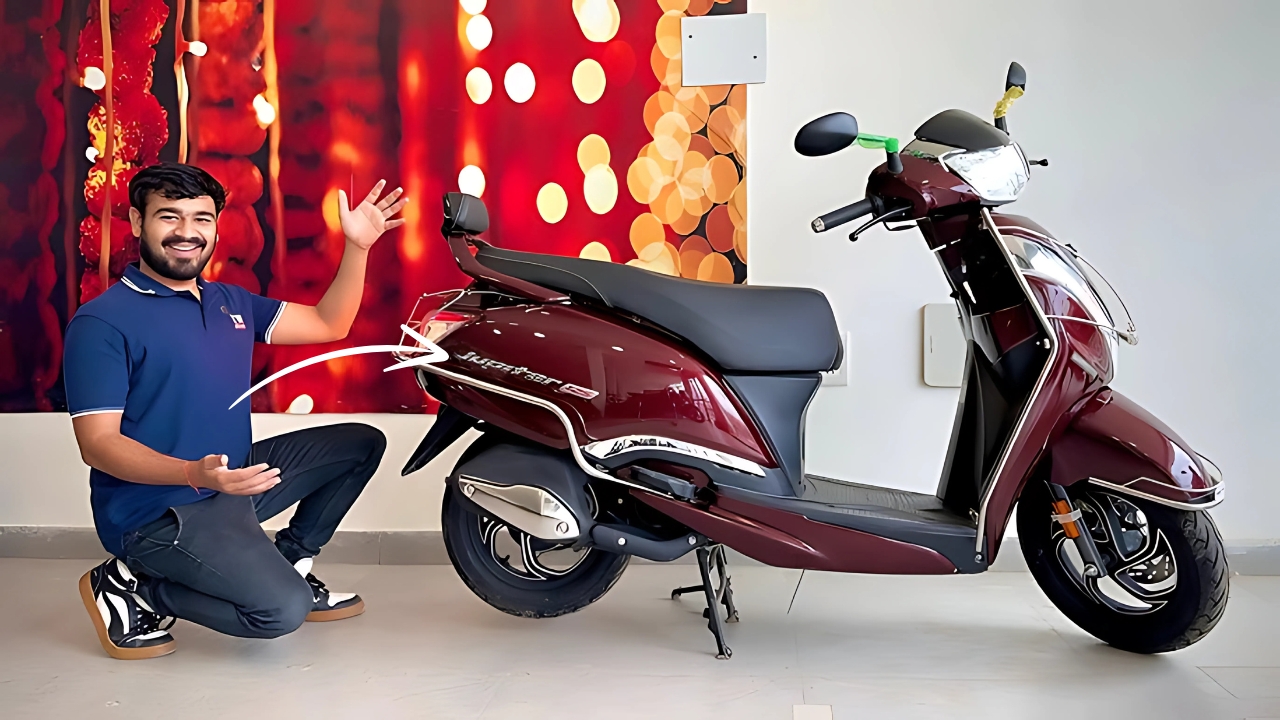In a groundbreaking move that’s set to reshape the Indian two-wheeler market, TVS Motor Company is gearing up to launch the world’s first factory-fitted CNG scooter.
The TVS Jupiter 125 CNG, slated for release in 2025, marks a significant milestone in the company’s commitment to alternative fuel technologies and sustainable mobility solutions.
A New Era of Eco-Friendly Commuting
As urban centers grapple with rising air pollution and skyrocketing fuel prices, the introduction of a CNG-powered scooter couldn’t be more timely.
The Jupiter 125 CNG promises to offer an economical and environmentally friendly alternative to traditional petrol-powered scooters, potentially revolutionizing the way millions of Indians commute daily.
TVS Motor Company, already a titan in the Indian two-wheeler industry, is leveraging its robust R&D capabilities to bring this innovative product to market.
The company’s decision to base its CNG offering on the popular Jupiter 125 model is a strategic one, building on an already successful platform that’s known for its spacious storage and unique design features.
Technical Innovations and Challenges
While specific details about the Jupiter 125 CNG remain under wraps, industry insiders speculate that the scooter will feature both a CNG tank and a conventional petrol tank, similar to the recently launched Bajaj Freedom 125 CNG motorcycle.
This dual-fuel system would offer riders the flexibility to switch between CNG and petrol, addressing potential range anxiety and ensuring practicality in areas where CNG filling stations might be scarce.
One of the most significant engineering challenges TVS faces is integrating the CNG tank into the scooter’s chassis without compromising on storage space or handling characteristics.
The Jupiter 125 is renowned for its under-seat storage capacity, and maintaining this selling point while accommodating a CNG cylinder will be crucial to the model’s success.
Experts anticipate that TVS will employ cutting-edge materials and design techniques to keep the overall weight in check, ensuring that the CNG variant maintains the agility and ease of use that scooter riders have come to expect.
Market Positioning and Pricing Strategy
TVS is expected to position the Jupiter 125 CNG as a premium offering within its scooter lineup.
With the Bajaj Freedom 125 CNG motorcycle priced between Rs 95,000 and Rs 1.10 lakh (ex-showroom), industry analysts predict that the Jupiter 125 CNG will be priced competitively in a similar range.
This pricing strategy would place the CNG scooter at a premium compared to its petrol counterpart but would be justified by the long-term fuel cost savings and reduced environmental impact.
TVS is likely to emphasize these benefits in its marketing campaigns, appealing to both cost-conscious consumers and environmentally aware riders.
Production Plans and Sales Targets
Sources close to the development have revealed that TVS has set an initial monthly sales target of around 1,000 units for the Jupiter 125 CNG.
This modest goal reflects a cautious approach to what is essentially a new product category in the Indian market.
The company is expected to ramp up production gradually, allowing for fine-tuning of the manufacturing process and gathering real-world feedback from early adopters.
This strategy aligns with TVS’s reputation for quality and reliability, ensuring that any teething issues are addressed before a wider rollout.
Impact on the Indian Two-Wheeler Market
The introduction of the TVS Jupiter 125 CNG is likely to spark a new trend in the Indian two-wheeler industry.
With Bajaj Auto already in the CNG space with its Freedom 125 motorcycle, and now TVS entering with a scooter offering, other major players like Honda, Hero MotoCorp, and Suzuki are expected to accelerate their own CNG two-wheeler projects.
This shift towards CNG could significantly alter the landscape of urban commuting in India.
As infrastructure for CNG refueling expands, particularly in major cities, CNG two-wheelers could become an increasingly attractive option for daily commuters looking to balance cost, convenience, and environmental responsibility.
Challenges and Opportunities
While the potential benefits of CNG scooters are clear, TVS will need to navigate several challenges to ensure the success of the Jupiter 125 CNG. These include:
- Infrastructure Development: The availability of CNG filling stations will be crucial. TVS may need to collaborate with energy companies and government bodies to expand the CNG network.
- Consumer Education: Many riders are unfamiliar with CNG vehicles. TVS will need to invest in educating consumers about the benefits and operation of CNG two-wheelers.
- Safety Concerns: Addressing any safety concerns related to CNG storage and usage in a scooter will be paramount to gaining consumer trust.
- Performance Perception: TVS will need to demonstrate that the CNG variant matches or exceeds the performance of its petrol counterpart to win over skeptical buyers.
Despite these challenges, the opportunities are immense. As India pushes towards cleaner energy solutions and seeks to reduce its dependence on imported oil, CNG two-wheelers could play a significant role in achieving these national objectives.
Looking Ahead
The TVS Jupiter 125 CNG represents more than just a new product launch; it’s a bold step towards a more sustainable future for personal transportation in India.
As the project moves from development to production, all eyes will be on TVS to see how this innovative offering performs in the real world.
If successful, the Jupiter 125 CNG could pave the way for a new generation of eco-friendly two-wheelers, potentially transforming the streets of Indian cities and setting a precedent for markets worldwide.
As we approach 2025, the anticipation builds not just for a new scooter, but for a glimpse into the future of urban mobility.
